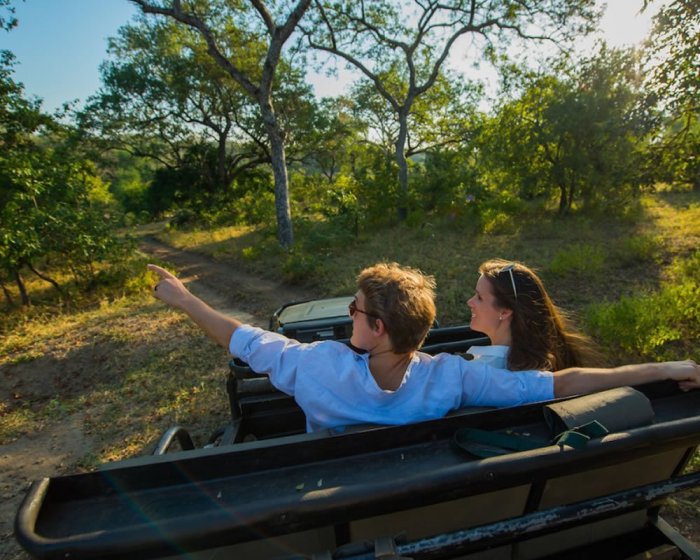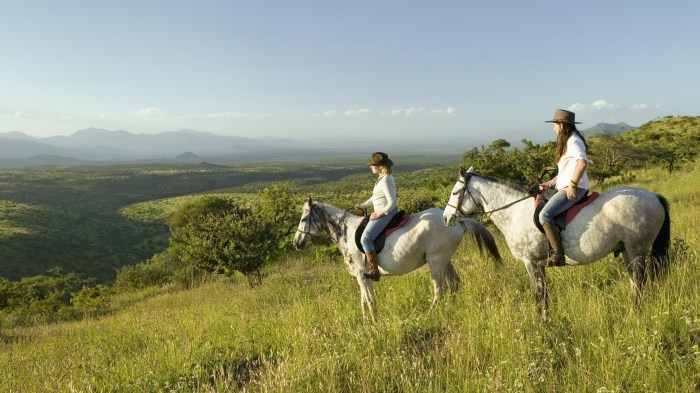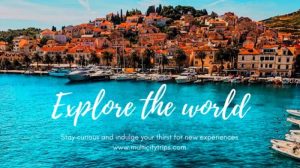
Africa beckons with unparalleled adventure, offering thrill-seekers a diverse landscape of exhilarating experiences. From scaling majestic mountains to exploring vibrant savannahs teeming with wildlife, the continent provides a unique blend of adrenaline-pumping activities and breathtaking scenery. This exploration delves into crafting unforgettable vacation programs tailored to various budgets and interests, ensuring an adventure perfectly suited to every thrill-seeker.
We’ll cover everything from meticulously planned itineraries and essential logistical considerations to insightful travel hacks and captivating photography tips. Understanding the diverse needs of adventure travelers, from budget backpackers to luxury adventurers, is crucial in designing truly immersive and rewarding experiences. The goal is to provide a comprehensive guide for planning and enjoying an African adventure that exceeds expectations.
Defining the Target Audience for Adventure-Packed African Vacations
African adventure vacations cater to a diverse range of thrill-seekers, each with unique motivations, budgets, and expectations. Understanding these diverse segments is crucial for designing effective marketing campaigns and crafting tailored travel experiences. This analysis will define three key target audience segments within the broader category of adventure travelers in Africa.
The psychographics of this target audience are defined by a strong desire for authentic experiences, a willingness to embrace challenges, and a passion for exploration and discovery. Demographics vary widely, encompassing individuals across age ranges, income levels, and family structures. However, a shared appreciation for nature, wildlife, and cultural immersion unites them.
Budget Backpackers
This segment comprises young adults and students, typically aged 18-35, with limited disposable income. They prioritize affordability and authentic experiences over luxury. Budget backpackers are often highly independent and resourceful, comfortable with basic accommodations and flexible itineraries. They seek opportunities for cultural immersion, interaction with local communities, and physically challenging activities like hiking, camping, and wildlife safaris on a budget.
Their travel style emphasizes value for money and a focus on personal growth through unique and challenging experiences. They may utilize hostels, guesthouses, and budget airlines, opting for self-guided tours or joining smaller, less expensive group tours.
Luxury Adventurers
This segment typically consists of higher-income individuals, aged 35-65, who seek premium comfort and personalized experiences. They are willing to invest significantly in high-end accommodations, private guides, and exclusive access to unique locations and activities. Luxury adventurers value privacy, personalized service, and unparalleled access to wildlife and adventure opportunities. Their travel preferences might include private safari lodges, helicopter tours, hot air balloon rides over the Serengeti, and exclusive guided trekking expeditions.
They prioritize comfort, convenience, and unique, unforgettable experiences, often seeking curated itineraries that cater to their specific interests and desires.
Family Adventurers
This segment includes families with children of various ages who are looking for adventure-filled vacations that are both exciting and safe. They may range from young families with toddlers to families with teenagers. Family adventurers prioritize activities suitable for all age groups, emphasizing safety and comfort while still offering exciting experiences. They often seek family-friendly lodges with childcare options, guided tours focusing on wildlife viewing and cultural immersion, and activities that cater to different age ranges and abilities.
Their travel style emphasizes shared experiences, creating lasting memories for the entire family, while balancing adventure with the practical needs of children. This segment will often seek activities such as game drives suitable for all ages, age-appropriate hiking trails, and cultural experiences with interactive elements for children.
Adventure Activities in Africa

Africa, a continent of breathtaking landscapes and diverse wildlife, offers an unparalleled playground for adventure seekers. From scaling majestic mountains to traversing vast deserts, the possibilities for thrilling experiences are seemingly endless. This section details a selection of adventure activities available across various regions of Africa, providing insights into their difficulty, duration, and potential risks. Understanding these factors is crucial for planning a safe and rewarding adventure.
Adventure Activities in Africa: A Comprehensive List
The following table categorizes various adventure activities by region, highlighting their difficulty level, typical duration, and inherent risks. Remember to always prioritize safety and choose activities appropriate for your skill level and physical condition. Consult with experienced guides and adhere to safety guidelines provided.
| Activity | Region | Difficulty | Description |
|---|---|---|---|
| Mount Kilimanjaro Climb | East Africa (Tanzania) | Challenging | A multi-day trek to the summit of Africa’s highest peak. Requires excellent physical fitness and acclimatization. Potential risks include altitude sickness, hypothermia, and unpredictable weather. Duration: 5-8 days. |
| Gorilla Trekking | East Africa (Rwanda, Uganda, DRC) | Moderate | Hiking through dense rainforest to observe mountain gorillas in their natural habitat. Requires a moderate level of fitness and a willingness to navigate challenging terrain. Potential risks include slippery trails, insect bites, and potential gorilla aggression (though rare with experienced guides). Duration: Half-day to full-day. |
| Safari in the Serengeti | East Africa (Tanzania) | Easy | Game drives and walking safaris to observe the abundant wildlife of the Serengeti National Park. Generally requires minimal physical exertion, though some walking may be involved. Potential risks include wildlife encounters (though mitigated by experienced guides) and sun exposure. Duration: Variable, depending on the tour. |
| White Water Rafting on the Zambezi River | Southern Africa (Zambia, Zimbabwe) | Challenging to Extreme (depending on the rapids) | Navigating the powerful rapids of the Zambezi River. Requires experience in white-water rafting and strong swimming skills. Potential risks include capsizing, injury from rocks, and strong currents. Duration: Half-day to multi-day trips. |
| Bungee Jumping in Bloukrans River | Southern Africa (South Africa) | Extreme | Leaping from a high bridge into a deep gorge. Requires overcoming a significant fear of heights. Potential risks include injury from impact or equipment malfunction. Duration: Short, single jump. |
| Shark Cage Diving | Southern Africa (South Africa) | Moderate | Observing great white sharks from within a protective cage. Requires overcoming a fear of sharks. Potential risks include equipment malfunction and unpredictable shark behavior (though minimized within the cage). Duration: Half-day. |
| Hiking in Table Mountain National Park | Southern Africa (South Africa) | Moderate | Exploring the diverse trails and breathtaking views of Table Mountain. Requires a moderate level of fitness. Potential risks include falls, dehydration, and exposure to the elements. Duration: Variable, depending on the trail. |
| Hot Air Balloon Safari | Various Regions | Easy | Soaring over the African landscape in a hot air balloon. Minimal physical exertion required. Potential risks are minimal, but weather conditions can affect flights. Duration: 1-2 hours. |
| Sandboarding in Namibia | Southern Africa (Namibia) | Easy to Moderate | Sliding down sand dunes on a board. Requires basic balance and coordination. Potential risks include falls and minor injuries. Duration: Half-day to full-day. |
| Quad Biking in the Sahara Desert | North Africa (Morocco, Tunisia, etc.) | Moderate | Exploring the desert landscape on a quad bike. Requires basic driving skills and some experience with off-road driving. Potential risks include accidents, dehydration, and getting lost. Duration: Half-day to full-day. |
| Camel Trekking in the Sahara Desert | North Africa (Morocco, Tunisia, etc.) | Easy | Exploring the desert on camelback. Minimal physical exertion required. Potential risks include saddle sores and sun exposure. Duration: Variable, from a few hours to multi-day trips. |
| Rock Climbing in Madagascar | East Africa (Madagascar) | Challenging to Extreme (depending on the route) | Scaling various rock formations. Requires significant rock climbing experience and specialized equipment. Potential risks include falls and injuries. Duration: Variable, depending on the route. |
| Wildlife Photography Safari | Various Regions | Easy | Capturing stunning images of African wildlife. Requires a camera and some basic photography skills. Potential risks are minimal, primarily related to wildlife encounters (mitigated by guides). Duration: Variable, depending on the tour. |
| Kayaking/Canoeing in Lake Victoria | East Africa (Uganda, Kenya, Tanzania) | Easy to Moderate | Exploring Lake Victoria by kayak or canoe. Requires basic paddling skills. Potential risks include capsizing and exposure to the elements. Duration: Variable, depending on the route. |
| Caving in the Drakensberg Mountains | Southern Africa (South Africa, Lesotho) | Moderate to Challenging | Exploring the extensive cave systems. Requires a good level of fitness and possibly specialized equipment for certain caves. Potential risks include falls, getting lost, and confined spaces. Duration: Variable, depending on the cave system. |
Crafting Unique Vacation Programs

Designing unique and appealing adventure vacation programs requires careful consideration of diverse budgets and interests. We’ve crafted three distinct programs to cater to a range of thrill-seekers, each offering a memorable African experience tailored to its price point. These programs highlight the incredible diversity of adventure opportunities across the continent, from luxurious safaris to budget-friendly explorations.
The following Artikels three distinct adventure-packed vacation programs, categorized by budget: Luxury, Mid-range, and Budget. Each program includes a detailed itinerary, highlighting accommodation, transportation, activities, and a cost estimate. Unique selling points are emphasized to showcase the individual appeal of each option.
Luxury African Safari Adventure: “The Royal Explorer”
This program prioritizes unparalleled comfort and exclusivity, offering access to premium lodges and unique wildlife encounters. It’s designed for discerning travelers who appreciate luxury and personalized service.
- Itinerary: 10 days/9 nights. Includes private game drives in Kruger National Park (South Africa), hot air balloon safari over the Masai Mara (Kenya), and a stay at a luxury lodge in Botswana’s Okavango Delta.
- Accommodation: Luxury lodges and private villas with personalized butler service. Examples include: Londolozi Private Game Reserve (Kruger), Four Seasons Safari Lodge Serengeti (Tanzania – similar experience level to Masai Mara), and Belmond Eagle Island Lodge (Okavango Delta).
- Transportation: Private chartered flights between locations, private safari vehicles with experienced guides.
- Activities: Private game drives, hot air balloon safari, guided walking safaris, boat safaris on the Okavango Delta, cultural visits to local villages.
- Estimated Cost: $30,000 – $50,000 per person (depending on the specific lodges chosen and time of year).
- Unique Selling Point: Unparalleled luxury and exclusivity, personalized service, access to exclusive locations and experiences.
Mid-Range African Adventure: “The Explorer’s Trail”
This program balances adventure and comfort, offering a diverse range of activities at a more accessible price point. It caters to travelers seeking a balance between thrilling experiences and reasonable cost.
- Itinerary: 7 days/6 nights. Includes gorilla trekking in Uganda’s Bwindi Impenetrable National Park, a safari in Tanzania’s Ngorongoro Crater, and a visit to a local market in Arusha.
- Accommodation: Comfortable mid-range lodges and hotels with good amenities. Examples include: Gorilla Forest Camp (Bwindi), Ngorongoro Serena Safari Lodge (Ngorongoro Crater), and a mid-range hotel in Arusha.
- Transportation: A mix of scheduled flights and comfortable safari vehicles with experienced guides.
- Activities: Gorilla trekking, game drives in the Ngorongoro Crater, cultural visits, hiking, and optional activities like a coffee plantation tour.
- Estimated Cost: $8,000 – $15,000 per person (depending on the time of year and specific activities chosen).
- Unique Selling Point: A well-rounded experience combining wildlife viewing, cultural immersion, and thrilling activities at a reasonable price.
Budget African Adventure: “The Wild Wanderer”
This program focuses on maximizing adventure and cultural experiences while minimizing costs. It’s ideal for budget-conscious travelers who prioritize authentic experiences over luxury.
- Itinerary: 10 days/9 nights. Includes backpacking through Morocco, exploring the Atlas Mountains, visiting Marrakech’s souks, and experiencing desert camping in the Sahara.
- Accommodation: A mix of hostels, guesthouses, and desert camping.
- Transportation: Local buses, trains, and taxis. Consider using ride-sharing apps where available.
- Activities: Hiking in the Atlas Mountains, exploring Marrakech’s souks and historical sites, camel trekking in the Sahara Desert, learning basic Arabic phrases from locals.
- Estimated Cost: $2,000 – $4,000 per person (excluding international flights; cost heavily dependent on travel style and choices of accommodation).
- Unique Selling Point: An immersive and authentic experience that allows for deeper cultural engagement at a fraction of the cost of other programs.
Travel Logistics and Practicalities
Planning an adventure-packed African vacation requires careful consideration of logistical details to ensure a smooth and enjoyable experience. This section Artikels essential information regarding visa requirements, travel insurance, and practical travel tips for a safe and culturally respectful journey. Failing to adequately prepare in these areas can significantly impact your trip.
Visa Requirements for African Countries
Visa regulations vary significantly across African nations. Citizens of some countries may enjoy visa-free entry or visa-on-arrival privileges, while others require pre-arranged visas. It’s crucial to check the specific requirements for your nationality and intended destinations well in advance of your trip. For example, citizens of the United States may require a visa for countries like Kenya, Tanzania, and South Africa, while those from certain European Union countries might find visa processes simpler.
The best approach is always to consult the official embassy or consulate website of each country you plan to visit. Always allow ample processing time, as visa applications can take several weeks or even months. Confirm the validity period of your visa to ensure it covers the entire duration of your stay.
Essential Travel Insurance and Adventure-Specific Coverage
Comprehensive travel insurance is paramount, especially for adventure travel in Africa. Standard policies may not cover activities like trekking, white-water rafting, or safaris. Adventure-specific policies provide broader coverage for injuries, medical emergencies, evacuations, and equipment loss incurred during high-risk activities. Consider factors like the level of adventure involved in your itinerary when selecting a policy. For example, a policy covering medical evacuation from remote areas is crucial for treks in mountainous regions.
Always carefully review the policy details, including coverage limits, exclusions, and claim procedures. Ensure the chosen policy covers the duration of your trip and includes sufficient medical coverage, given the potential for unexpected medical issues in remote locations.
Practical Travel Tips for Packing, Safety, and Cultural Respect
Packing appropriately is vital for a comfortable and safe journey. Consider the climate, planned activities, and local customs. Pack lightweight, versatile clothing suitable for various weather conditions, sturdy footwear appropriate for hiking and trekking, and necessary toiletries. It’s wise to include insect repellent, sunscreen, and a first-aid kit. For safety, be aware of your surroundings, avoid displaying valuables openly, and use reputable transportation services.
Familiarize yourself with local laws and customs, and always respect local traditions and sensitivities. This might include dressing modestly when visiting religious sites or being mindful of local customs surrounding photography. Learning a few basic phrases in the local language can also greatly enhance your interactions with the local community and show respect for their culture.
Travel Photography and Storytelling
Capturing the breathtaking landscapes and thrilling experiences of an African adventure requires more than just pointing and shooting. This section delves into the techniques and considerations for creating stunning travel photos and weaving them into a compelling visual narrative that truly captures the spirit of your journey. We will explore essential equipment, photography techniques, and strategies for sharing your story on social media.Your African adventure photos should be more than just snapshots; they should evoke emotion and transport viewers to the heart of your experience.
By understanding the fundamentals of composition, lighting, and storytelling, you can transform your images from simple records of events into powerful visual narratives.
Camera Equipment and Settings
Choosing the right equipment is crucial for capturing high-quality images in diverse African environments. A versatile DSLR or mirrorless camera with interchangeable lenses offers the greatest flexibility. A wide-angle lens is essential for capturing expansive landscapes, while a telephoto lens allows you to zoom in on wildlife from a safe distance. Consider a sturdy tripod for sharp images, especially in low-light conditions.
For optimal image quality, shoot in RAW format, which provides greater flexibility in post-processing. Understanding your camera’s settings, such as aperture, shutter speed, and ISO, is also paramount for achieving the desired depth of field and exposure. Experiment with different settings to understand their impact on your images.
Photography Techniques for Stunning African Shots
Mastering several key photographic techniques significantly enhances your ability to capture the essence of your African adventure. The “rule of thirds,” a fundamental compositional guideline, involves placing key elements off-center to create a more visually appealing image. Leading lines, such as roads or rivers, can draw the viewer’s eye into the scene. Using natural light effectively is crucial; the golden hour (sunrise and sunset) provides warm, soft light ideal for landscape and wildlife photography.
Pay attention to the background; a cluttered background can detract from your subject. Experiment with different perspectives – get down low to the ground for unique angles or climb higher for a broader view.
Creating a Compelling Visual Narrative
A strong visual narrative goes beyond individual stunning photos; it’s about sequencing images to tell a story. Consider the order in which you present your photos to build a cohesive narrative. Start with establishing shots to set the scene, then move to detail shots that highlight specific moments or elements. Include images that showcase the diversity of your experience, from landscapes to wildlife encounters to cultural interactions.
Use captions and descriptions to add context and emotion to your images, enriching the storytelling experience. A well-crafted visual narrative allows viewers to not only see your journey but also feel it.
Sample Social Media Post
Imagine a photo showcasing a majestic lion pride at sunset in the Serengeti. The image, taken with a telephoto lens, features the lions bathed in the warm golden light, their manes glowing. The background is a vast, sprawling savanna. The caption could read: “Witnessing the magic of the Serengeti sunset with this incredible lion pride. The silence was broken only by the gentle rustle of the grass and the distant call of a bird.
An unforgettable moment on my African adventure! #AfricanSafari #Serengeti #WildlifePhotography #TravelPhotography #LionPride #SunsetSafari” This post uses a compelling image, a descriptive caption that evokes emotion, and relevant hashtags to increase visibility. The image itself depicts a clear subject with a pleasing composition, enhancing the overall impact of the post.
Travel Hacks for Budget-Conscious Travelers
Planning an adventurous African vacation shouldn’t break the bank. With a little planning and savvy strategies, you can experience the thrill of Africa without sacrificing your financial well-being. This section Artikels practical tips and tricks to help you maximize your budget and minimize your expenses.
Flight Cost Reduction Strategies
Securing affordable flights is crucial for budget travel. Consider booking flights well in advance, ideally several months prior to your departure, to take advantage of early bird discounts. Flexibility with your travel dates can also significantly impact the price. Mid-week flights and those avoiding peak seasons (school holidays and major events) are generally cheaper. Using flight comparison websites to search across multiple airlines simultaneously can uncover hidden bargains.
Finally, consider flying into smaller, less popular airports near your destination; these often offer lower fares than major international hubs.
Accommodation Savings Techniques
Accommodation accounts for a significant portion of travel expenses. Exploring options beyond luxury hotels is key to saving money. Hostels offer budget-friendly dorm rooms and private rooms, fostering a social atmosphere and opportunities to meet fellow travelers. Airbnb and similar platforms provide access to a wider range of accommodations, from private apartments to unique local homes, often at more competitive prices than hotels.
Consider camping or staying in guesthouses for a truly immersive and affordable experience, especially in rural areas. Remember to check reviews before booking to ensure quality and safety.
Cost-Effective Activity Selection
Many incredible African experiences are surprisingly affordable. Opting for free or low-cost activities, such as hiking, exploring local markets, and visiting free museums or historical sites, can drastically reduce your spending. Look for discounts and group deals on activities like safaris or guided tours. Consider self-guided tours, using readily available resources like maps and guidebooks, to reduce reliance on paid guides.
Engaging with local communities and participating in their cultural activities can be both enriching and budget-friendly.
Utilizing Local Transportation Methods
Relying on local transportation networks is a fantastic way to save money and gain a deeper understanding of the local culture. Buses and minibuses are common and inexpensive options for traveling between cities and towns. Within cities, consider using taxis or ride-sharing apps (where available) for shorter distances. Walking or cycling, when safe and practical, offers a free and healthy way to explore.
Remember to negotiate fares before embarking on any journey, especially with taxis.
Budget Travel Option Evaluation
Various budget travel options exist in Africa, each with advantages and disadvantages. Backpacking offers ultimate flexibility and cost-effectiveness but requires more planning and self-sufficiency. Organized group tours offer convenience and structure but can be more expensive. Independent travel allows for personalized itineraries but demands more research and logistical planning. Choosing the right option depends on your travel style, budget, and comfort level.
For example, backpacking might be ideal for adventurous solo travelers, while organized tours may suit those prioritizing convenience and ease.
Urban Escapes within African Adventure Itineraries
Balancing the thrill of African wilderness adventures with the vibrant energy of its cities creates a truly unforgettable travel experience. A well-planned itinerary can seamlessly integrate urban exploration with wildlife encounters, offering a richer and more diverse perspective on the continent. This section highlights three diverse African cities that provide a compelling counterpoint to the wild landscapes, enriching the overall adventure.
Vibrant African Cities for Urban Exploration
Three cities offering a striking contrast to the typical African safari experience are Cape Town, South Africa; Marrakech, Morocco; and Nairobi, Kenya. Each offers a unique blend of history, culture, and modern amenities, providing a welcome respite and a chance to experience a different facet of African life. These urban escapes add depth and cultural richness to any adventure vacation.
Cape Town, South Africa: A Blend of History and Modernity
Cape Town boasts stunning natural beauty alongside a rich history and vibrant culture. Visitors can explore Table Mountain, with its iconic flat top, offering breathtaking panoramic views of the city and coastline. A cable car ride provides a comfortable ascent, while more adventurous travelers can hike up various trails. Furthermore, a visit to the historic Company’s Garden offers a peaceful escape and a glimpse into Cape Town’s colonial past, showcasing historical buildings and lush greenery.
The garden provides a contrast to the bustling city and serves as a tranquil retreat.
Marrakech, Morocco: A Sensory Overload of Culture and History
Marrakech, a city steeped in history and vibrant with culture, offers a sensory feast. The Djemaa el-Fna square, a UNESCO World Heritage site, transforms from a bustling marketplace by day into a vibrant spectacle of storytellers, musicians, and food vendors at night. This square is a living embodiment of Moroccan culture. Exploring the labyrinthine souks (markets) is an experience in itself, with the sights, sounds, and smells of spices, textiles, and handicrafts creating an immersive sensory experience.
The souks offer a glimpse into traditional Moroccan craftsmanship and commerce.
Nairobi, Kenya: A Modern African Metropolis
Nairobi, Kenya’s capital city, is a bustling metropolis that offers a fascinating blend of modern development and traditional African culture. A visit to the Karen Blixen Museum provides insight into the colonial era and the life of the famous author. The museum showcases colonial architecture and artifacts, offering a historical perspective. The Giraffe Centre, on the other hand, allows for an up-close encounter with endangered Rothschild giraffes, offering a unique blend of urban and wildlife experiences.
This unique experience showcases conservation efforts within an urban setting.
Integrating Urban Escapes into Adventure Itineraries
To seamlessly integrate these urban escapes into a broader adventure vacation program, consider strategically placing them between wilderness excursions. For instance, after a safari in the Maasai Mara, a few days in Nairobi can provide a refreshing change of pace before embarking on a mountain climbing adventure. Similarly, a city break in Cape Town can serve as a relaxing transition between a wildlife safari in Kruger National Park and a wine-tasting tour in the Cape Winelands.
Careful planning of flight and ground transportation is crucial to minimize travel time and maximize the enjoyment of each location. The key is to balance the intensity of adventure activities with periods of relaxation and cultural immersion in the city.
Exploring the Business Side of Adventure Travel
The African adventure tourism sector presents a compelling investment opportunity, brimming with potential for significant returns. However, navigating this landscape requires a keen understanding of both the challenges and the rewards. This section will delve into the financial aspects of this burgeoning industry, examining venture capital interest, entrepreneurial hurdles, and a hypothetical business plan for a thriving African adventure travel company.Venture capital investment in African adventure tourism is steadily increasing, driven by the continent’s unique natural beauty, growing middle class with disposable income, and the global rise in demand for experiential travel.
Investors are drawn to the potential for high returns and the positive impact such ventures can have on local communities. However, the perceived risks associated with infrastructure limitations, political instability in certain regions, and the need for sustainable practices remain key considerations.
Venture Capital Investment Potential in African Adventure Tourism
Several factors contribute to the attractiveness of the African adventure tourism sector for venture capitalists. The rising global popularity of experiential travel, coupled with Africa’s diverse landscapes and wildlife, creates a high demand for authentic adventure experiences. This translates into significant revenue potential for well-managed businesses. Furthermore, responsible tourism initiatives, focusing on community involvement and environmental sustainability, are increasingly important to both investors and consumers, presenting opportunities for businesses that prioritize these aspects.
Successful examples include companies focusing on ecotourism, community-based tourism, and wildlife conservation initiatives, which have attracted substantial funding and demonstrated impressive growth. For example, a company specializing in gorilla trekking tours in Rwanda, focusing on community engagement and sustainable practices, secured significant investment from a global impact investing firm based on its demonstrable positive social and environmental impact.
Challenges and Opportunities for Entrepreneurs
Entrepreneurs in the African adventure tourism sector face both significant challenges and exciting opportunities. Challenges include navigating complex regulatory environments, managing logistical complexities in remote areas, ensuring the safety and well-being of tourists, and mitigating environmental impacts. Opportunities include capitalizing on the growing demand for unique and authentic experiences, developing innovative tourism products, partnering with local communities to create sustainable and inclusive tourism models, and leveraging technology to enhance the tourist experience and streamline operations.
For instance, a successful entrepreneur might leverage mobile technology to create a seamless booking and communication system for clients, while simultaneously engaging local guides and communities through a digital platform.
Hypothetical Business Plan: “Safari & Summits”
This hypothetical business plan Artikels a new adventure travel company, “Safari & Summits,” operating in East Africa. The company will focus on offering curated adventure experiences combining wildlife safaris with mountain climbing expeditions in Tanzania and Kenya.
Mission Statement:
To provide unforgettable, sustainable adventure travel experiences in East Africa, fostering cultural exchange and environmental stewardship.
Target Market:
Affluent, adventurous travelers aged 30-55, interested in unique and challenging experiences. Emphasis will be placed on attracting environmentally conscious travelers.
Products and Services:
A range of packaged tours combining wildlife safaris in national parks with guided climbs of Mount Kilimanjaro and Mount Kenya. The company will offer various levels of difficulty, catering to different fitness levels. Additional services will include pre-trip planning, in-country support, and high-quality photography packages.
Marketing Strategy:
A multi-channel approach will be used, including online marketing, partnerships with travel agents, and participation in relevant travel trade shows. Emphasis will be placed on showcasing the unique aspects of the experiences and highlighting the company’s commitment to sustainability.
Financial Projections:
Detailed financial projections, including start-up costs, revenue forecasts, and profitability analysis, will be developed based on market research and competitive analysis. The business plan will demonstrate the potential for significant return on investment, justifying the need for venture capital funding. These projections would consider factors like seasonal demand, pricing strategies, and operational expenses. A conservative estimate might project profitability within the first three years of operation, based on successful marketing and operational efficiency.
Management Team:
A team with experience in both the adventure tourism sector and business management will be assembled. This team will possess the necessary expertise to navigate the challenges of operating in the African market while delivering high-quality experiences.
Vacation Packages and Program Design Considerations
Designing successful adventure vacation programs in Africa requires careful consideration of various factors, from the type of package offered to the inherent risks involved. The right approach ensures a memorable and safe experience for travelers while maintaining the sustainability of the destination and the business.Different vacation package models cater to diverse traveler preferences and budgets. Understanding these models and their implications is crucial for program design.
Comparison of Adventure Vacation Package Models
Three primary models exist: all-inclusive, customized, and group tours. All-inclusive packages offer comprehensive coverage, encompassing flights, accommodation, activities, and meals. This simplifies planning but may lack flexibility. Customized packages, conversely, offer maximum flexibility, allowing travelers to tailor their itineraries to their specific interests and budget. However, they require more planning and may be more expensive.
Group tours provide a cost-effective option with pre-planned itineraries and the benefit of shared experiences with like-minded individuals; however, they offer less individual freedom. The choice depends on the target audience and their preferences. For example, a younger, budget-conscious traveler might prefer a group tour, while a luxury traveler might opt for a customized package.
Key Elements in Designing Successful Adventure Vacation Programs
Designing a successful program necessitates meticulous planning across several key areas. Risk assessment is paramount. This involves identifying potential hazards (e.g., wildlife encounters, challenging terrain, extreme weather) and implementing mitigation strategies (e.g., providing safety briefings, employing experienced guides, having emergency protocols). Sustainability is equally vital. Programs should minimize their environmental impact, support local communities, and respect cultural sensitivities.
This could involve using eco-friendly transportation, sourcing locally, and employing local guides. Furthermore, clear communication, detailed itineraries, and appropriate pricing strategies are essential components for a successful program. For instance, a program focused on gorilla trekking in Rwanda might incorporate community-based tourism initiatives by partnering with local villages, ensuring a portion of the revenue benefits the local community.
Checklist for Evaluating Adventure Vacation Program Quality and Safety
Before recommending or participating in an adventure vacation program, a thorough evaluation is necessary. This checklist helps assess the program’s quality and safety:
- Operator Experience and Reputation: Research the operator’s history, licenses, and reviews.
- Safety Protocols and Emergency Procedures: Verify the presence of comprehensive safety measures and emergency plans.
- Guide Qualifications and Experience: Assess the guides’ training, certifications, and experience level in the specific activity.
- Equipment Quality and Maintenance: Check the condition and maintenance of equipment used in activities.
- Insurance Coverage: Ensure adequate insurance coverage for participants in case of accidents or emergencies.
- Environmental Sustainability Practices: Evaluate the operator’s commitment to environmental protection and responsible tourism.
- Customer Reviews and Testimonials: Read reviews from past participants to gauge their experiences.
- Transparency and Communication: Assess the clarity of communication and the level of transparency provided by the operator.
Using this checklist enables a comprehensive assessment of a program’s quality and safety, minimizing risks and ensuring a positive experience.
Ultimately, planning an adventure-packed African vacation requires careful consideration of individual preferences, budget constraints, and logistical details. By combining thorough research, thoughtful planning, and a healthy dose of adventurous spirit, travelers can unlock unforgettable experiences in this captivating continent. Remember to prioritize safety, respect local cultures, and capture the magic of your journey through stunning photography and compelling storytelling.
The thrill of the unknown awaits!
Frequently Asked Questions
What vaccinations are recommended for travel to Africa?
Vaccination requirements vary depending on the specific region and your country of origin. Consult your doctor or a travel clinic well in advance of your trip for personalized recommendations.
What’s the best time of year to visit Africa for adventure travel?
The ideal time depends on the region and the specific activities planned. Generally, the dry seasons (typically June-October in East and Southern Africa) offer the best weather for many activities.
How safe is adventure travel in Africa?
Safety varies by region and activity. Choosing reputable tour operators, adhering to safety guidelines, and being aware of your surroundings are crucial. Comprehensive travel insurance is highly recommended.
Are there opportunities for solo travel in Africa?
Yes, many tour operators cater to solo travelers, offering group tours or customized itineraries. However, careful planning and consideration of safety are especially important for solo adventurers.





